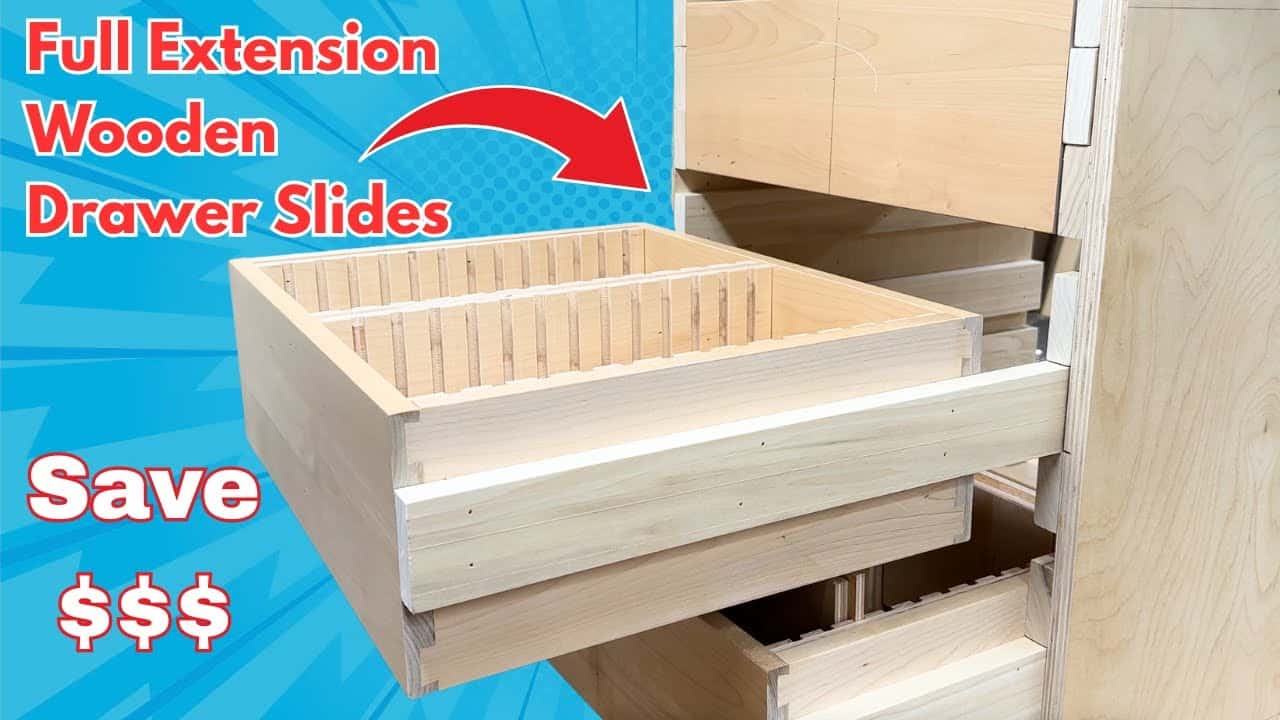This project was built and designed by Jon Peters of Longview Woodworking.
It’s a smart, budget-friendly solution that uses wooden drawer slides instead of metal hardware, fitted into a shop cabinet designed around donated drawers.
Rather than reworking drawer boxes that were cut to the wrong size, Jon built a cabinet to fit them—resulting in a mobile, functional unit tailored for art storage.
His approach shows how to get smooth drawer action, save on materials, and make practical design decisions when dealing with off-size or repurposed components.
Watch the full video and subscribe to Jon’s channel:
Why Choose Wooden Slides
Wooden drawer runners are ideal for shop furniture and utility cabinets. Jon highlights a few clear advantages: they’re inexpensive, made from scrap wood, and easy to install using basic tools.
When done right, they also last for decades and can be repaired or replaced easily if needed.
For woodworkers trying to stay efficient and cost-conscious, they offer a simple alternative to metal drawer slides—especially when full-extension or soft-close features aren’t necessary.
Designing Around Existing Drawers
Jon’s starting point for this build was a set of drawers that had been ordered incorrectly. Instead of wasting time resizing them, he let the drawers dictate the cabinet size and layout.
This reversed design process meant fewer modifications and guaranteed a good fit. It also allowed Jon to tailor the cabinet’s function, making it perfect for storing small painting panels upright with internal spacing that keeps them from touching.
Building the Runners and Rails
To support the drawers, Jon fabricated simple wooden runners from shop scraps. The key to success is getting the spacing right between each drawer and keeping the cleats aligned on both the cabinet and drawer sides.
He used temporary spacers to position the runners accurately before gluing and nailing them in place. A few light nails hold the runners securely while still allowing for minor wood movement, helping prevent seasonal binding.
Using Spacers for Consistent Placement
One of Jon’s most effective techniques was creating a spacer block to transfer runner placement.
This block was cut to match the distance between the top of the drawer and the runner, ensuring each slide was positioned identically across all drawers.
By using the spacer to align the cabinet cleats, Jon made sure the drawers stayed level, moved smoothly, and didn’t rack during operation. This small step saved time and made a big difference in fit and finish.
Allowing for Wood Movement
Instead of rigidly locking everything in place, Jon intentionally leaves a little wiggle room in the joints. For example, when attaching the top runner to the drawer face, he uses glue sparingly and allows the nails to float slightly.
This flexibility is crucial in environments with changing humidity. A drawer that works perfectly in winter might bind in summer unless the joints can adjust subtly.
Smoothing the Slides
To finish the interior and improve drawer movement, Jon applies a thin spray coat to the cabinet walls, avoiding heavy finishes that could cause sticking.
Once dry, he lightly sands the surface and then rubs candle wax along the runners.
This old-school method produces quiet, consistent action and extends the life of the wooden runners. It’s simple, effective, and easy to reapply over time.
Tailoring the Cabinet for Art Storage
The drawers are specifically used to store small painting panels. By adding dividers or adjusting interior spacing, Jon turned a basic cabinet into an efficient art storage unit that protects drying panels and keeps them organized.
This kind of functional planning—where a cabinet is designed around real-world use—is what makes the piece so valuable in the shop. It’s not just about storage, but how that storage supports your work.
Adding Mobility
Jon mounted the finished cabinet on a set of salvaged casters. This lets him move it around the studio as needed, keeping his space flexible and adaptable.
He recommends locking casters for stability, as well as distributing weight evenly to prevent tipping.
Even with a bit of unused space at the rear of the cabinet, the ability to move it easily makes it a highly useful build.
Practical Tips for Success
Jon’s video is packed with small but useful tips. Among them:
- Test fit runners before final assembly.
- Avoid over-gluing any part that needs to slide or shift.
- Use simple, square runner profiles that are easy to finish and wax.
- Secure cleats with light nails, not heavy screws, to allow for movement.
- Consider using reclaimed or donated parts to save time and money.
When to Use Metal Slides Instead
While wooden runners work well in many applications, Jon notes they may not be ideal for heavy drawers or situations where full extension is critical. In those cases, metal hardware with ball bearings might be a better fit.
But for shop builds, art storage, or utility furniture, wooden slides are more than capable—and they often look cleaner and feel more natural in custom pieces.
Support Jon by shopping his plans here: https://jonpeters.com/collections/plans.
